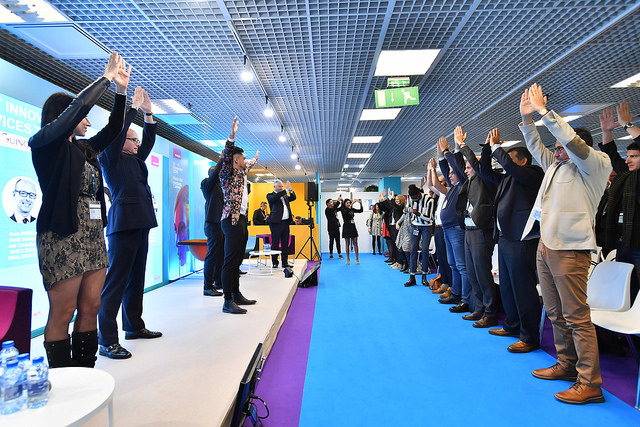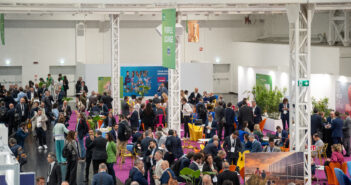This morning, we made our way to Palais des Festivals de Cannes under clear skies, with the freshness of the sea and a sense of retail transformation in the air. From then on, MAPIC Day two delivered an electric showcase of hot retail trends, concepts and insights from industry leaders. Here’s what we learned at today’s dynamic conferences.
Session – Destination: France Part I
The focus was clear in Conference Room Two as Jérôme Parigi, Deputy Editor, LSA, kicked off- a highly relevant discussion about the French retail market. Within the experienced panel, Parigi was joined by Antoine Frey, CEO of Frey and Chairman of the CNCC. Frey, who is working on the reclassification of peripheral areas of France, which he says are in fact urban districts, was adamant about the importance of developing outwards and protecting areas on the outskirts of city centres.
“If we don’t take care of our peripheries properly, we are heading straight to an economic catastrophe” – Antoine Frey, CEO, Frey
The focus is clear in Room 2. Jérôme Prigi, @LSAconsommation begins ‘Destination: France Part I’ with @CwDubois, @CushWake, @Antoine_Frey, #Frey, Stephen Goenaga, @KiabiFrance, @rober_herrmann, Eurometropole de Strausbourg @Emanuelroch4, #Procos & David Terrien, @MDM_FR #MAPIC pic.twitter.com/kNzsghBZrD
— MAPICWorld (@MAPICWorld) 15 November 2018
A key component in the development of Frey’s successful retail parks located in such areas has been the close relationship held with local municipalities; a more collaborative effort to create unique destinations that deliver exactly what the customer wants.
Robert Herrmann, President, Eurométropole de Strasbourg agreed with the notion. Discussing the master-planning of cities, Herrmann noted that “Eurométropole is a strong example. It has been a true pioneer in the new model that encourages partnerships between private and public actors to redevelop cities to accommodate retail parks”.
We came away from the session with a keenness to keep our eyes on the French market – big moves are being made, and opportunities are live.
Session – Transit zones: strategic physical locations to serve connected users
If there is anything that the past year has taught us, it is that transit zones offer incredible growth opportunities for retailers, and significant development potential. With this in mind, we were delighted to see Andrea Aiello, Editor in Chief, Retail & Food, kick off our session dedicated to exploring the strategic opportunities of transit zones in the age of digital.
Vivian Braun, WW Marketing Leader, IBM gave an insightful overview of the current market, noting the challenges of greater competition amongst retailers.
More
” Competition is helping consumers who have higher and higher expectations in terms of quality and relevance.” – Vivian Braun, WW Marketing Leader, IBM
Andrea Aiello from #edifis begins “Transit zones:strategic physical #locations to serve connected users”with Enrico Destro @Luxottica, Vivian Braun @IBM, Steven Dumas @urw_group, Alessandro Zanotti @Accenture, Audre Landy @CEETRUS_Corp and Melanie Guilldou @LagardereTR #MAPIC pic.twitter.com/xiFDOCu45l
— MAPICWorld (@MAPICWorld) 15 November 2018
For this reason, according to Braun, consideration of customer preferences and exceeding their expectations is essential. In terms of transit zones, some might argue that investment in a customer-centric approach can restrict efficiency, which is key for customers on the move – but not Vivian Braun, who is a champion of digital solutions.
“It doesn’t have to be a choice between being customer-centric and efficient…why can’t we let technology do the heavy lifting?… where man and machine combine” – Vivian Braun, WW Marketing Leader, IBM
We also heard from Steven Dumas, SVP Design, Unibail-Rodamco-Westfield, who noted that “We are at the cusp of a new evolution in travel retail – transforming transit zones into a fully integrated part of the customer journey”.

Mixed use retail and leisure: What happens next? – White Paper
He drew our attention to a key question that airport and other transit zone operators should ask themselves about their retail arm – how can we make our customers’ journeys easier? This is a question that should drive decision-making across multiple functions of an airport: distribution zones, Wi-Fi, operations, pick-ups – the list goes on.
Dumas also pointed out that today’s best airports are generally considered so because they have the best brands – but the leading airports of tomorrow will work with retailers and incorporate the digital technology and operations to create a special and unique experience.
“If you look at airports these days, the best ones have the best brands, but they are all offering the same products…digital allows us to transform the product itself” – Steven Dumas, SVP Design
The future of transit zones was perhaps captured most concisely by Alessandro Zanotti, Managing Director/ Digital Customer Products Lead, Accenture.
“A transit zone of tomorrow will cover all of the main functions – technology, wellness, retail…even smart-shopping” – Alessandro Zanotti, Managing Director/ Digital Customer Products Lead, Accenture
Session: Best innovative beauty and wellness services to create customer value”
This panel was moderated by Charlotte Journo-Baur, CEO, WISHIBAM and explored how beauty retailers, spas and fitness centres are transforming their physical space into service platforms. The digital era has presented a new business opportunity for the industry to fill empty space and increase customer satisfaction in modernised physical stores.
“Beauty online is just as important as the retail experience, however, you will never have a sensory experience online. You must have the product in your hand to smell, taste and understand it” said Jamie Taylor, Retail, Property and Wholesale Director at L’Occitane En Provence. “In today’s world, lifestyle and experience are more important than the product if you can create a reason for someone to come back to a physical location.”
The speakers discussed how new tools allow brands to adapt to millennials’ lifestyle and respond to their unique needs. They also analysed how to incorporate innovative technology such as virtual reality into their brands to better serve the needs of customers.
“In today’s environment, the culture is so local. It’s about connecting with the customer and making it feel local even within an international brand” – Danielle Larsen, Vice President of International Acquisitions at Equinox Fitness
Edouard Falguieres, Franchise Director at Guinot, shared how the global beauty brand creates its unique formula for success. Guinot is renowned for combining professional in-house services with their skincare products to achieve the best results.
“Beauty is very personalised and you need to have the experience customised for your skin and your body. This requires you to meet with your beautician for the best results…We promote treatments more than product.” – Edouard Falguieres, Franchise Director at Guinot.
Finally, the panellists discussed how to make the physical shopping experience more meaningful, personal and convenient. Beauty and wellness brands should aim to achieve a 360-degree wellness lifestyle for their clients. For example, Equinox is opening their first 215-key flagship hotel this year at Hudson Yards in New York, which allows the brand to penetrate other aspects of their members’ lives outside of the gym.
“Equinox is not just a gym, it’s a lifestyle and we maximize the potential in all of our members in all that they do, not just fitness…Customer loyalty is being driven by the lifestyle created through the brand. The fashion side of the business has created brands like Sweaty Betty, Lululemon and Bandier. The convergence of fashion, fitness and experience is a major part of the business that we are focused on going forward.” – Danielle Larsen, Vice President of International Acquisitions, Equinox Fitness.
The overarching takeaway from the panel was that creating memorable in-store experiences and making brands an integral part of a client’s routine will become increasingly important for the future of the beauty and wellness industry.
“Our vision is about creating memories through inspiration storytelling. We are using virtual reality at our store on Fifth Avenue in New York as part of our storytelling. We want to go from being a shop to being a flagship experiential centre.” – Jamie Taylor, Retail, Property and Wholesale Director, L’Occitane En Provence
The “Beauty and Wellness” panel moderated by @chajourno w/ Jamie Taylor of @LOCCITANE_UK, Pierre-Matthieu Louis of La Salle du Temps, Danielle Larsen of @Equinox, Edouard Falguieres of @GuinotUKIreland and Sean Briggs of White Star Real Estate begins w/ stretching and breathing! pic.twitter.com/fmSUBW7MHh
— MAPICWorld (@MAPICWorld) 15 November 2018
Session – Retail, a booster for tourism!
A final must-see panel assessed the incredible value of thriving retail to international tourism sectors. A UK project of note was introduced by Sam Cotton, Head of Retail Leasing for Battersea Power Station.
“We are creating a brand-new Zone 1 station in London. Battersea Station has been here for many years, but we have decided to invest in a new destination because we have seen an opportunity to create a wonderful neighbourhood in one of the most iconic cities in the world.” – Sam Cotton, Head of Retail Leasing, Battersea Power Station
The development will see a landmark Grade II listed building in south west London – a decommissioned coal-fired power station – transformed as one of the most exciting and innovative mixed-use neighbourhoods in the world. The idea is to create a destination with a rich history – a story – for locals and specifically tourists to enjoy a top selection of shopping, restaurants and cultural spaces.
“From the research we have conducted, we found out that what people want to see the most is the story behind a retail project. They want a place that is leading them to a historical journey with great experiences…arriving by boat to get access to the shopping centre is definitely a great experience for tourists” – Sam Cotton, Head of Retail Leasing, Battersea Power Station
“There is no unique model of #outlet but the key ingredient to attract more visitors involves pragmatism. We have to be pragmatic in our #tourism model, with smart #marketing strategy and support from major #investors” – @_Vincent_Moreau from @Advantail #MAPIC pic.twitter.com/qIw7VuOQIw
— MAPICWorld (@MAPICWorld) 15 November 2018
Aja Gruden, Director of Customer Relationship and International Development, Le BHV Marais, Galeries Lafayette Group, provided some insight into her priorities for investing in stores that are attractive to tourists. Galeries Lafayette is going through an amazing period of transformation with store enhancements, taking into consideration cultural and environmental factors to generate an optimal experience.
“We are investing a lot in the Paris district of Galeries Lafayette. We want to create cultural and environmental shopping experiences that go beyond just going to a shopping centre” – Aja Gruden, Director of Customer Relationship and International Development, Le BHV Marais, Galeries Lafayette Group
Vincent Moreau, Marketing Director, Advantail, led the discussion to outlet centres, and how best to attract tourists to areas outside of city centres to shop. As you might expect from a leading expert in the marketing field, his advice to the audience was valuable.
“There is no unique model for outlets, but the key ingredient to attracting more visitors involves pragmatism. We have to be pragmatic in our tourism model, with smart marketing strategies and support from major investors” – Vincent Moreau, Marketing Director, Advantail.
Day two was filled with inspiring retail conferences where panellists revealed the key ingredients of the new retail recipe, and guided audiences with insight into the ne innovative solutions that are transforming the sector.
These were just a handful of our significant take-aways, and there is still more to come. Stay tuned for Day three.








![[NEW] MAPIC interview: In conversation with Sostrene Grene CEO Mikkel Grene Sostrene-Grene](https://www.beyondretailindustry.com/wp-content/uploads/2024/03/Inside-Sostrene-Grene-store-5-1-351x185.jpg)
![[NEW] Women in Retail: 24 trailblazers for 2024 Women in retail](https://www.beyondretailindustry.com/wp-content/uploads/2024/03/image-1-351x185.png)
